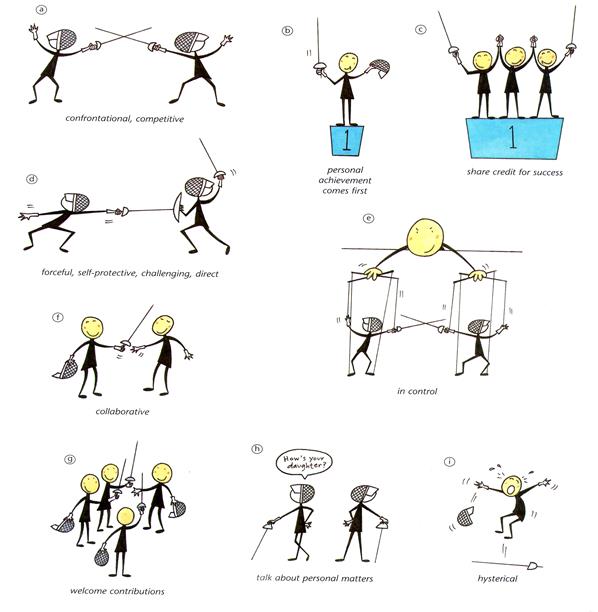IV. Problem-solving activity
The different styles depend on the situation and the relationship behavior (amount of support required) and task behavior (amount of guidance required).
Can you guess which management styles would work best for each situation? Should managers use only one management style? Or situational style?
Listed below are a few situations and options for what you would do. Try to decide which of the four situational styles would work best in each situation. Then pick the option that best fits that style.
Situation 1
The employees in your program appear to be having serious problems getting the job done. Their performance has been going downhill rapidly. They have not responded to your efforts to be friendly or to your expressions of concern for their welfare.
Which style would you pick? What would you do?
Reestablish the need for following program procedures and meeting the expectations for task accomplishment.
Be sure that staff members know you are available for discussion, but don’t pressure them.
Talk with your employees and then set performance goals.
Wait and see what happens.
Situation 2
During the past few months, the quality of work done by staff members has been increasing. Record keeping is accurate and up to date. You have been careful to make sure that the staff members are aware of your performance expectations.
Which style would you pick? What would you do?
Stay uninvolved.
Continue to emphasize the importance of completing tasks and meeting deadlines.
Be supportive and provide clear feedback. Continue to make sure that staff members are aware of performance expectations.
Make every effort to let staff members feel important and involved in the decision making process.
Situation 3
Performance and interpersonal relations among your staff have been good. You have normally left them alone. However, a new situation has developed, and it appears that staff members are unable to solve the problem themselves.
Which style would you pick? What would you do?
Bring the group together and work as a team to solve the problem.
Continue to leave them alone to work it out.
Act quickly and firmly to identify the problem and establish procedures to correct it
Encourage the staff to work on the problem, letting them know you are available as a resource and for discussion if they need you.
Situation 4
You are considering a major change in your program. Your staff has a fine record of accomplishment and a strong commitment to excellence. They are supportive of the need for change and have been involved in the planning.
Which style would you pick? What would you do?
Continue to involve the staff in the planning, but direct the change.
Announce the changes and then implement them with close supervision.
Allow the group to be involved in developing the change, but don’t push the process.
Let the staff manage the change process.
Lesson 3. Men vs. women
Warm up
I. Discuss in groups:
a)What is the style of male and female managers in companies in your country? Are they similar?
b)Do you think there is a difference in style between men and women or is any difference usually because of personality?
c)Do you know any men who have a ‘female’ style of working? Or women who have a ‘male’ style of working?
d)Do you find it easier to work with men or women? Why?
II. The same or different?
Do men and women bring different qualities to business or is it nonsense to talk about male and female management styles?
Decide whether the following management qualities are more typical of men, more typical of women or shared by both. Which of these qualities do you think you possess yourself?
1. Being able to take the initiative
2. Being a good listener.
3. Staying calm under pressure.
4. Being prepared to take risks.
5. Being conscientious and thorough.
6. Having good communication skills.
7. Being energetic and assertive.
8. Getting the best out of people.
9. Being independent and authoritative.
10. Being supportive towards colleagues.
11. Being able to delegate.
12. Motivating by example.
13. Having a co-operative approach.
14. Being single-minded and determined.
15. Being a good time-manage
Reading
I. Read the text about the different styles that men and women have in the workplace. Look at the cartoon and say which figures you think represent men and which represent women.
Men and women do things differently. There are, of course, exceptions to every generalization, including this one.Cristina Stuart is a managing director of Speakeasy Training, a consultancy that runs courses for men and women working together. Here she describes a few key differences between the sexes in the workplace.
Working together
 The male approach to business is competitive, direct and confrontational. The end justifies the means. Personal status and a focus on the individual are important.
The male approach to business is competitive, direct and confrontational. The end justifies the means. Personal status and a focus on the individual are important.
The female method is collaborative. Collective action and responsibility are more important than personal achievement. Lateral thinking, as well as goodwill and the well-being of the individual, are also of great importance.
Tackling problems
The male approach is to go to the heart of the problem, without taking into account secondary considerations. The female preference is to look at various options.
Body language
Male body language tends to be challenging. Female body language tends towards self-protection. A stereotypical female pose is sitting cross-legged; the male sits with legs apart to give an impression that he is in control.
Male behaviour can include forceful gestures for example banging a fist on the desk for effect. The female style does not usually include aggressive gestures.
Language
The male way of speaking does not encourage discussion. Women tend to welcome others’ opinions and contributions more.
Conversation
Men like to talk about their personal experiences and achievements or discuss ‘masculine’ topics such as cars or sport. Women tend to talk about staff problems and personal matters.
Meetings
If a woman does not copy the male confrontational style, she is often ignored.
Self-promotion
Men find it easy to tell others about their successes. Women tend to share or pass on the credit for a success.
Humour
Men's humour can be cruel – a man’s joke usually has a victim. Female makes jokes against herself as a CAVEAT.Many men have a female style of working. Equally many women have a male approach.As Ms Stuart says many of the current management theorems – flatter organizations, empowerment, managing by consensus – have a female style to them.
· the end justifies the means: it doesn’t matter what methods you use; success is the only important thing;
· lateral thinking: thinking in a creative way, making unusual connections;
· flatter organizations: organizations in which there are fewer managers and people have equal status;
· managing by consensus: managing by getting everyone to agree.
Mark Powell, Ron Martinez, Rosi Jillett, New Business Matters, Coursebook

